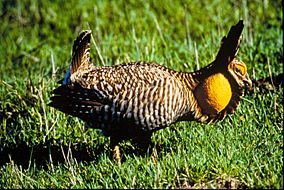Attwater Prairie Chicken National Wildlife Refuge facts for kids
Quick facts for kids Attwater Prairie Chicken National Wildlife Refuge |
|
|---|---|
|
IUCN Category IV (Habitat/Species Management Area)
|
|

Attwater's prairie chicken
|
|
| Location | Colorado County, Texas, United States |
| Nearest city | Sealy, Texas |
| Area | 10,528 acres (42.61 km2) |
| Established | 1972 |
| Governing body | U.S. Fish and Wildlife Service |
| Website | Attwater Prairie Chicken National Wildlife Refuge |
| Designated: | 1968 |
The Attwater Prairie Chicken National Wildlife Refuge is a special place in southeast Texas, United States. It's a protected area that helps save one of the biggest parts of the original coastal prairie habitat. This refuge is super important because it's home to one of the last groups of the Attwater's prairie chicken. This bird is a type of grouse that lives on the ground and is in danger of disappearing forever.
The refuge covers about 10,528 acres (43 square kilometers). That's a huge area! It's located in Colorado County, which is about 60 miles (100 km) west of Houston. This special place was created in 1972. It's one of only a few national wildlife refuges that were made specifically to protect an endangered species. In 1968, before it was a full refuge, it was named a National Natural Landmark. This means it's a very important natural site.
Contents
How the Refuge Started
In the mid-1960s, a group called the World Wildlife Fund bought a large piece of land. They bought about 3,500 acres (14 square kilometers). Their goal was to save some of the remaining coastal prairie for the Attwater's prairie chicken.
Later, in 1972, this land was given to the United States Fish and Wildlife Service. This government agency now manages the refuge. With this addition, the refuge grew to its current size.
Helping the Attwater's Prairie Chicken
Many of the Attwater's prairie chickens you might see at the refuge were actually born somewhere else. They come from special breeding programs. These programs are at places like Fossil Rim Wildlife Center, Texas A&M University, SeaWorld San Antonio, Abilene Zoo, Caldwell Zoo, Houston Zoo, and San Antonio Zoo.
When the young chicks are big enough to live on their own, they get a tiny radio transmitter. This little device helps scientists track them. Then, the chicks are released into the refuge. This helps grow the wild population of these rare birds.
Keeping the Prairie Healthy
The people who work at the refuge do a lot to keep the prairie healthy. One important thing they do is called a prescribed burn. This means they carefully set small fires on purpose. They burn about 2,000 to 3,000 acres (8 to 12 square kilometers) every year. These burns usually happen in January or February.
These fires might sound scary, but they are very helpful! They remove dead plants and help new, strong grasses grow. They also stop unwanted plants and bushes from taking over. The staff also works to turn old farm fields back into natural prairie. They do this by planting native grasses that belong there.
Animals and Plants You Might See
The Attwater's prairie chicken is the star, but over 250 other kinds of birds live here too! You might spot colorful birds like the fulvous whistling duck or the roseate spoonbill. Other birds include the black-bellied whistling duck, white-tailed hawk, crested caracara, scissor-tailed flycatcher, dickcissel, anhinga, Sprague's pipit, and sandhill crane.
Many different mammals also call the refuge home. You could see plains bison, thirteen-lined ground squirrels, bobcats, coyotes, nine-banded armadillos, and white-tailed deer. In the ponds, you might find American alligators swimming with softshell turtles. If you listen closely, you might hear the calls of American bullfrogs and upland chorus frogs.
The refuge is also full of beautiful wildflowers. In the spring, you can see bright Indian paintbrush, blue bluebonnets, and orange Butterfly milkweed. These flowers make the prairie very colorful!
Visiting the Refuge
You can explore the refuge in a couple of ways. There's an auto tour loop that's about five miles (8 km) long. You can drive your car through it and see the coastal prairie habitat.
If you like to walk, there are two hiking trails. The Pipit Trail goes to Refuge Lake and is about 1.5 miles long. The Sycamore Trail is about 1.2 miles (1.9 km) long. It goes through the coastal prairie and also a forest area near Coushatta Creek.
Attwater Prairie Chicken National Wildlife Refuge gallery
![]() This article incorporates public domain material from websites or documents of the United States Fish and Wildlife Service.
This article incorporates public domain material from websites or documents of the United States Fish and Wildlife Service.
















